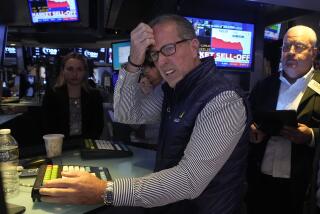Dollar Drops to New Postwar Low Against Yen : Finance: The fall baffles some analysts. Others say it rebuffs the management of the U.S. economy.
The U.S. dollar Friday again sank to a postwar low against the Japanese yen, extending a slide that is further eroding the greenback’s role as perhaps the world’s premier currency and raising more questions about the United States’ ability to manage economic problems at home and abroad.
Despite massive dollar purchases in foreign-exchange markets by the Federal Reserve Board and other central banks, the greenback also tumbled to a 2 1/2-year low against the German mark and lost ground against several other European currencies.
At the end of trading Friday in New York, it took only 94.05 yen to buy a dollar--the lowest since Japan’s postwar exchange rates were set in the late 1940s--down from 95.26 Thursday. Against the German mark, the dollar traded at 1.4250 marks, down from 1.4415 Thursday.
At first glance, the dollar’s slump seems baffling. The U.S. economy is expanding nicely, inflation is relatively low, the Fed is signaling stable interest rates this year and the Dow Jones industrial average is trading near a record high of 4,000.
Even some analysts are surprised. “At the start of the year, the outlook for the dollar seemed pretty bright,” said John R. Williams, chief global markets economist at Bankers Trust New York Corp.
But Williams and other analysts say several factors--some psychological, some technical and all somewhat subtle in nature--are leaving foreign-exchange markets uneasy about holding lots of dollars.
Traders are worried that the United States is struggling to manage economic threats caused by future U.S. inflation prospects, the huge U.S. merchandise trade deficit and the financial meltdown of Mexico for which the White House has promised billions of dollars in aid.
At the same time, many currency investors see the German Bundesbank and the Bank of Japan as being more focused on keeping their currencies strong and their interest rates relatively high. That trend, plus those nations’ recovering economies, are helping the mark and yen supplant the U.S. dollar as the “safe haven” currency for investors in times of political and economic turmoil worldwide.
Traders also fret that while the German and Japanese central banks are expected to keep raising interest rates to curb inflation--and making yen- and mark-denominated investments more attractive as a result--the United States is willing to let U.S. rates fall this year.
Fed Chairman Alan Greenspan already has indicated that the Fed, which raised U.S. rates repeatedly during the past 12 months, does not plan to hike rates further in 1995.
“All of this has led investors to question the resolve of the Federal Reserve to do whatever is necessary to combat inflation” in the United States, said John Ryding, senior economist at the investment firm Bear, Stearns & Co. in New York.
Gary Schlossberg, senior economist at Wells Fargo Bank in San Francisco, said “rightly or wrongly, confidence in U.S. economic management is eroding once again.”
For instance, the Republicans’ failure Thursday to pass a balanced budget amendment--a key part of the party’s “contract with America”--raises doubts among traders about the U.S. effort to reduce the budget deficit, Schlossberg said.
The U.S. effort to support its dollar is also being questioned. Although the Fed and the other central banks bought more than $1.5 billion in the past two days, it did little to stop the dollar’s slide.
“It was one of the least successful bouts of intervention we’ve had in some time,” said Monica Williams, foreign-exchange manager at Sanwa Bank California in Los Angeles.
Is the dollar’s slide something most Americans should fret about? Several analysts say no, even though fallout from the dollar’s losses will have tangible effects.
For instance, the lower dollar means U.S. imports from Japan, Germany and other nations--whose currencies are gaining against the dollar--will cost more, which could lift U.S. inflation and exacerbate its trade deficit.
Inflation, in turn, pares the value of Americans’ fixed-income investments such as Treasury bills and bond mutual funds.
“In the end, a falling dollar means one thing, a reduction in the wealth of the United States versus the wealth of the rest of the world,” Ryding said.
But there is also benefits. Major U.S. exporters get a lift because overseas customers have more purchasing power relative to the dollar. And some analysts emphasized that while the dollar is struggling against the yen, mark and other currencies, it is not collapsing worldwide.
Indeed, the dollar in the past year has risen against the Canadian dollar and the Mexican peso, which is important because those two countries are among the United States’ biggest trading partners, analysts said.
That means the dollar has more purchasing value relative to those currencies, which shaves the prices Americans pay for their imports from those nations.
* RATES RISE
Bond yields rise sharply. D2.
More to Read
Inside the business of entertainment
The Wide Shot brings you news, analysis and insights on everything from streaming wars to production — and what it all means for the future.
You may occasionally receive promotional content from the Los Angeles Times.











